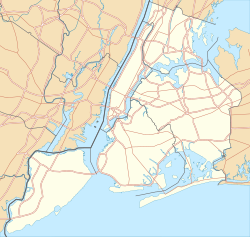Lincoln Club | |
 | |
| Location | 65 Putnam Ave., New York, New York |
|---|---|
| Coordinates | 40°40′59″N73°57′35″W / 40.68306°N 73.95972°W |
| Area | less than one acre |
| Built | 1886 |
| Architect | Rudolph L. Daus |
| Architectural style | Queen Anne |
| NRHP reference No. | 83001693 [1] |
| Significant dates | |
| Added to NRHP | January 27, 1983 |
| Designated NYCL | May 12, 1981 |
Lincoln Club, also known as Mechanics Temple, Independent Order of Mechanics of the Western Hemisphere, is a historic clubhouse in Clinton Hill, Brooklyn, New York, New York. It was built between 1886 and 1889 and is a 4+1⁄2-story Queen Anne style masonry building. It is built of Roman brick and rock-faced Lake Superior brownstone with smooth brownstone bands and terra cotta ornament. It has a sunken basement and the front facade features four distinctive arches on the first floor and a 2-story oriel window. [2]
Contents
It was listed on the National Register of Historic Places in 1983. [1]



